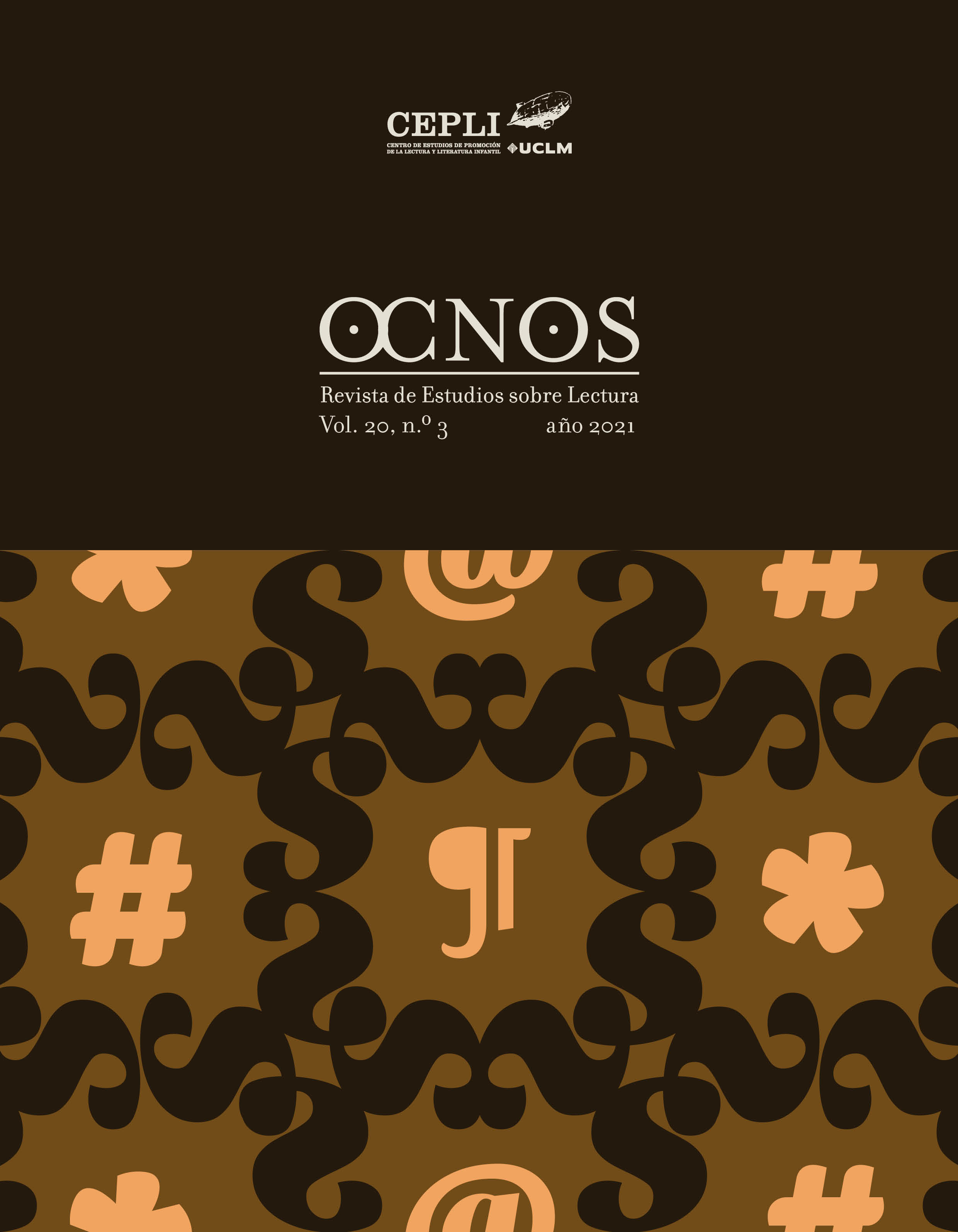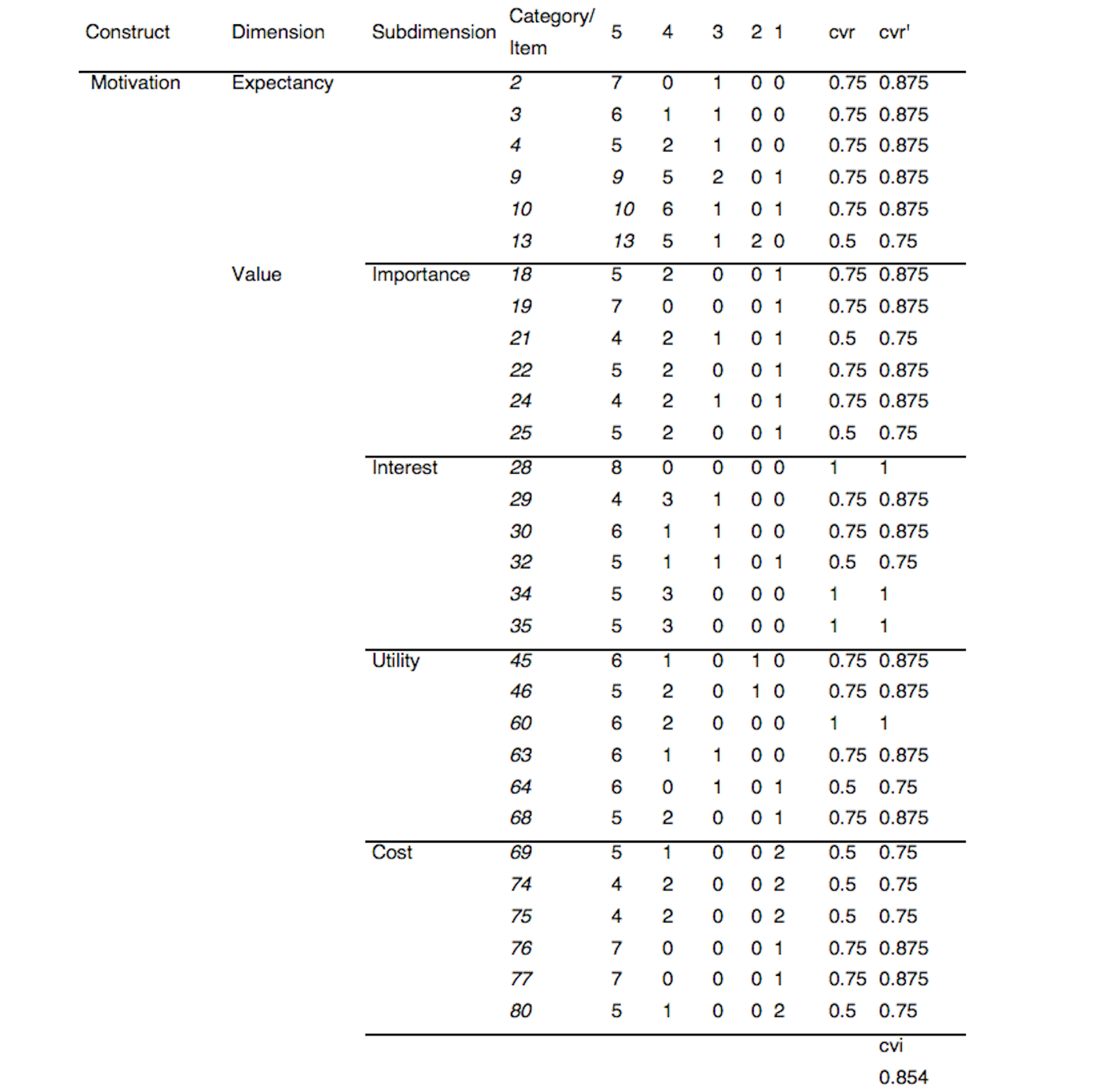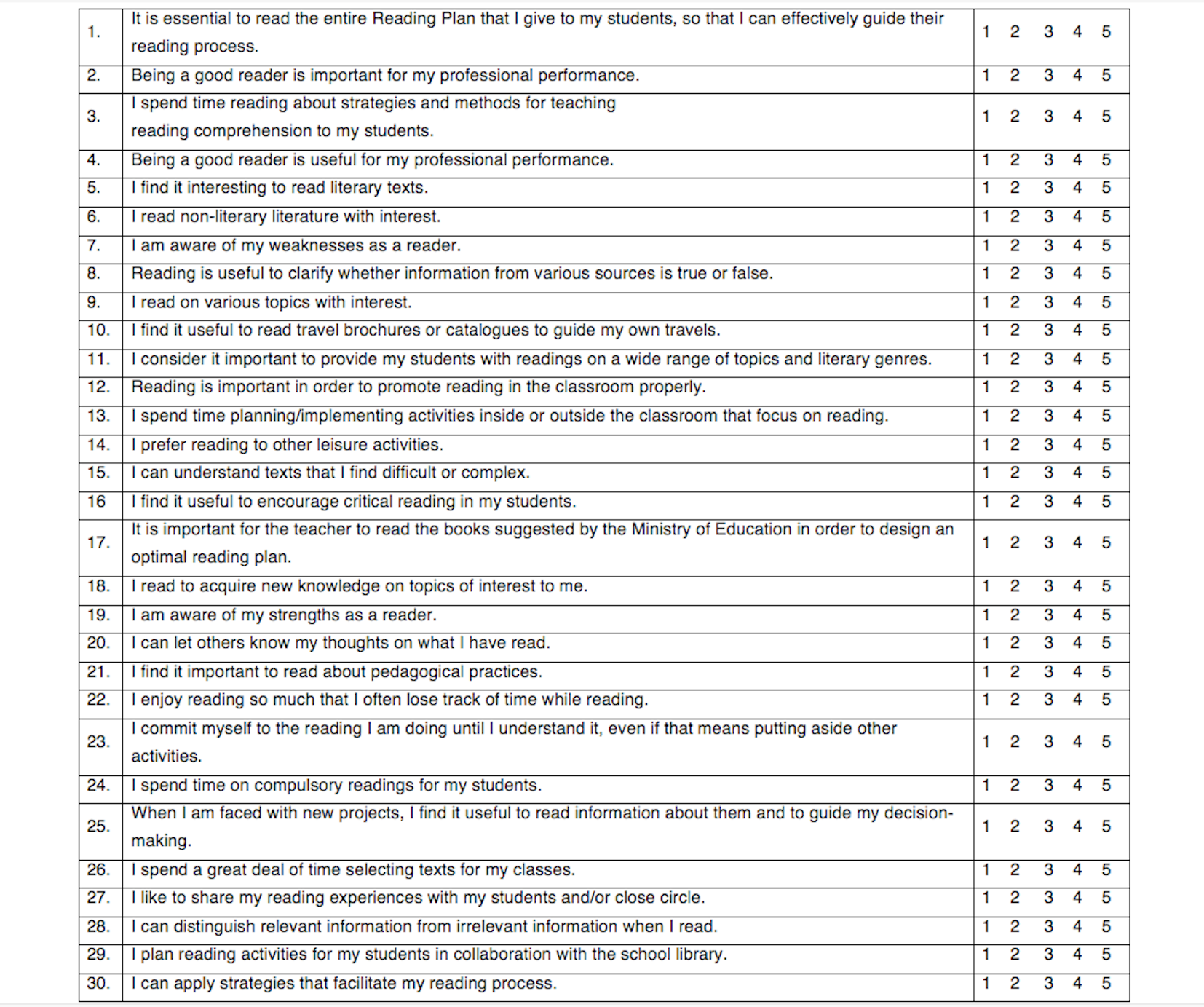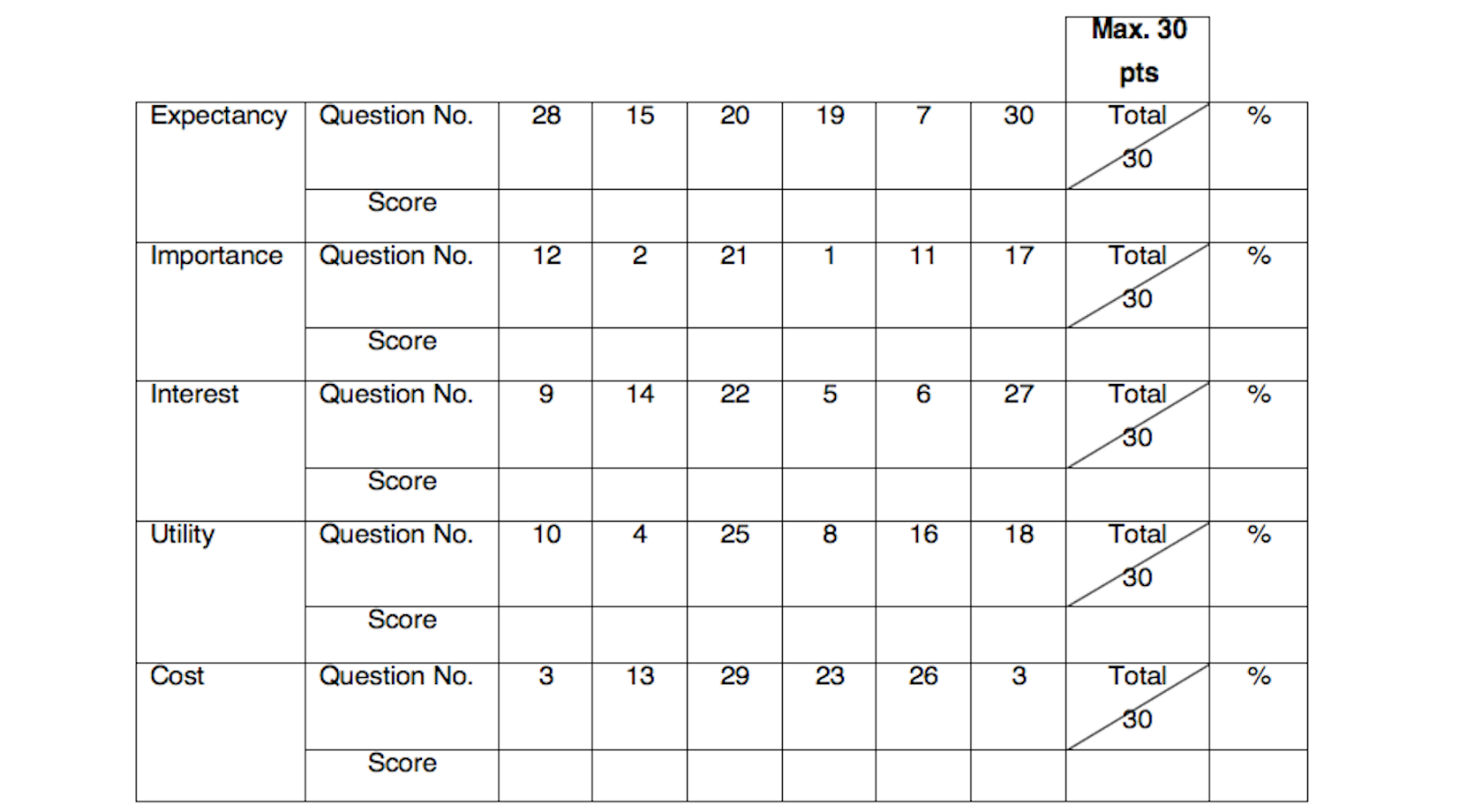Applegate, A., & Applegate, M. (2004). The Peter effect: Reading habits and attitudes of preservice teachers. Reading Teacher, 57(6), 554-565.
Applegate, A. J., Applegate, M. D., Mercantini, C. M., Cobb, J. B., DeBoy, J. R., Modla, V., & Lewinski, K. E. (2014) The Peter Effect Revisited: Reading Habits and Attitudes of College Students. Literacy Research and Instruction, 53:3, 188-204. https://doi.org/10.1080/19388071.2014.898719
Asfura, E., & Real, N. (2019). La lectura literaria al egreso de la formación inicial docente. Un retrato de las prácticas lectoras declaradas por estudiantes de pedagogía en educación secundaria en lenguaje y comunicación. Calidad en la educación, (50), 83-113. http://doi.org/10.31619/caledu.n50.719
Asselin, M. (2000). Confronting assumptions: Preservice teachers´ beliefs about reading and literature. Reading Psychology, 21(1), 31-55. https://doi.org/10.1080/027027100278338
Atkinson, J. (1964). An Introduction Motivation. VanNostrand
Bandura, A. (1977). Self-efficacy: toward a unifying theory of behavioral change. Psychological Review, 84(2), 191. https://doi.org/10.1037/0033-295X.84.2.191
Bandura, A. (1993). Perceived self-efficacy in cognitive development and functioning. Educational Psychologist, 28(2), 117-148. https://doi.org/10.1207/s15326985ep2802_3
Benevides, T., & Peterson, S. (2010). Literacy attitudes, habits and achievements of future teachers. Journal of Education for Teaching, 36(3), 291-302. https://doi.org/10.1080/02607476.2010.497375
Boggs, M., & Golden, F. (2009). Insights: Literacy Memories of Preservice Teachers Self-Reported Categories of Impact. Reading Matrix: An International Online Journal, 9(2), 211-223. http://www.readingmatrix.com/journal.html
Carreño, Á., & Garrido, J. M. (2013). Aprendizaje motivado en alumnos universitarios: validación y resultados generales de una escala. Revista de Investigación Educativa, 31(2), 347-347. https://doi.org/10.6018/rie.31.2.163581
Cohen, R., Swerdlik, M., & Velázquez, J. (2001). Pruebas y evaluación psicológicas-Introducción a las pruebas y a la medición (4ª edición). Mc Graw Hill.
Clavero, F. H., Salguero, M. I. R., Venegas, J. M. R., & Ramírez, I. H. (2004). Tratamiento de las creencias motivacionales en contextos educativos pluriculturales. Revista Iberoamericana de Educación, 34(1), 1-21. https://doi.org/10.35362/rie3412885
Commeyras, M., Bisplinghoff, B., & Olson, J. (2003). Teachers as readers. Perspectives on the Importance of Reading in Teachers’ Classrooms and Lives. International Reading Association. http://www.uilis.unsyiah.ac.id/oer/files/original/01532b0c1b2aff17e99ce310617569c1.pdf
Cremin, T., Mottram, M., Collins, F., Powell, S., & Safford, K. (2009). Teachers as readers: building communities of readers. Literacy, 43(1), 11-19. https://doi.org/10.1111/j.1741-4369.2009.00515.x
Cremin, T., Bearne, E., Mottram, M., & Goodwin, P. (2008). Primary teachers as readers: Primary teachers as readers. English in Education, 42(1), 8-23. https://doi.org/10.1111/j.1754-8845.2007.00001.x
Deci, E., Ryan, R. (1985). Intrinsic Motivation and Self-determination in Human Behavior. Plenum, 86, 18-19. https://doi.org/10.1007/978-1-4899-2271-7
Dellinger, A., Bobbett, J., Olivier, D., & Ellett, C. (2008). Measuring teachers’ self-efficacy beliefs: Development and use of the TEBS-Self. Teaching and Teacher Education, 24(3), 751-766. https://doi.org/10.1016/j.tate.2007.02.010
Dueñas, J., Tabernero, R. Calvo, V., & Consejo, E. (2014). La lectura literaria ante nuevos retos: Canon y mediación en la trayectoria lectora de futuros profesores. Ocnos, 11, 21-43. https://doi.org/10.18239/ocnos_2014.11.02
Eccles, J., & Wigfield, A. (2002). Motivational beliefs, values, and goals. Annual Review of Psychology, 53(1), 109-132. https://doi.org/10.1146/annurev.psych.53.100901.135153
Eccles, J., Wigfield, A., & Schiefele, U. (1998). Motivation to Succeed. In W. Damon (Series Ed.) & N. Eisenberg (Vol. Ed.), Handbook of Child Psychology: Vol. 3. Social, Emotional, and Personality Development (5th ed., pp. 1017-1095). Wiley.
Eccles, J., & Wigfield, A. (1995). In the mind of the actor: The structure of adolescents’ achievement task values and expectancy-related beliefs. Personality and Social Psychology Bulletin, 21(3), 215-225. https://doi.org/10.1177/0146167295213003
Elche, M., & Yubero, S. (2019). La compleja relación de los docentes con la lectura: el comportamiento lector del profesorado de educación infantil y primaria en formación. Bordón. Revista De Pedagogía, 71(1), 31-45. https://doi.org/10.13042/Bordon.2019.66083
Émery-Bruneau, J. (2010). Le rapport à la lecture littéraire: des pratiques et conceptions de sujets-lecteurs en formation à l'enseignement du français à des intentions didactiques. [Dissertation, Faculté des Sciences de l'Éducation: Université Laval, Quèbec]. https://corpus.ulaval.ca/jspui/bitstream/20.500.11794/21444/1/27627.pdf
Falardeau, E., Simard, D., Carrier, L., & Gauvin-Fiset, L. (2011). Le rôle de l’affectivité dans l’enseignement de la littérature: portraits d’enseignants lecteurs. In C. Mazauric, M. Fourtanier, & G. Langlade (Dir.), Textes de lecteurs en formation (pp. 61-70). Peter Lang.
Fanfani, E. (2005). La Condición Docente. Editores Argentina.
Granado, C. (2014). Teachers as readers: a study of the reading habits of future teachers (El docente como lector: estudio de los hábitos lectores de futuros docentes). Cultura y Educación, 26(1), 44-70. https://doi.org/10.1080/11356405.2014.908666
Granado, C., & Puig, M. (2014). ¿Qué leen los futuros maestros y maestras? Un estudio del docente como sujeto lector a través de los títulos de libros que evocan. Ocnos 11, 93-112. https://doi.org/10.18239/ocnos_2014.11.05
Gupta, R. (2004). Old habits die hard: literacy practices of pre-service teachers. Journal of Education for Teaching, 30(1), 67-78. https://doi.org/10.1080/0260747032000162325
Guthrie, J. (1996). Educational contexts for engagement in literacy. The Reading Teacher, 49(6), 432-445.
Larrañaga, E., & Yubero, S. (2005). El hábito lector como actitud. El origen de la categoría de “falsos lectores”. Ocnos, 26(1), 44-70. https://doi.org/10.18239/ocnos_2005.01.04
Lawshe, C. (1975). A Quantitative Approach to Content Validity 1. Personnel Psychology, 1, 563–575. https://doi.org/10.1111/j.1744-6570.1975.tb01393.x
López-Valero, A., Encabo, E., & Jerez, I. (2016). Consideraciones docentes e investigadoras para la Didáctica de la literatura en Educación Infantil y en Educación Primaria. Lenguaje y Textos, 43, 7-14. https://doi:10.4995/lyt.2016.5820
Magnusson, D. (1990). Teoría de los Test (2nd ed.). Editorial Trillas.
Manresa, M. (2011). Els Hàbits lectors dels adolescents efectes de les actuacions escolars en les pràctiques de lectura. [Dissertation, Universitat Autònoma de Barcelona]. https://ddd.uab.cat/record/98719
Meece, J., Wigfield, A., & Eccles, J. (1990). Predictors of math anxiety and its influence on young adolescents' course enrollment intentions and performance in mathematics. Journal of Educational Psychology, 82(1), 60. https://doi.org/10.1037/0022-0663.82.1.60
McClelland, D. C. (1985). How motives, skills, and values determine what people do. American Psychologist, 40(7), 812–825. https://doi.org/10.1037/0003-066X.40.7.812
MINEDUC (2018). Bases Curriculares Primero a Sexto Básico. Santiago: Unidad de Curriculum y Evaluación. Ministerio de Educación. https://curriculumnacional.mineduc.cl/614/articles-22394_bases.pdf.
MINEDUC (2015). Bases Curriculares 7° Básico a 2° Medio. Santiago: Unidad de Curriculum y Evaluación. Ministerio de Educación. https://curriculumnacional.mineduc.cl/614/articles-34949_Bases.pdf.
Miret, I. (2008). Bibliotecas escolares, (aún más) hoy. In J.A. Millán (Coord.). La lectura en España. Informe 2008 (pp. 93-105). Fundación Germán Sánchez Ruipérez. http://www.fge.es/lalectura/docs/miret.pdf
Mueller, D. (1973). Teacher attitudes toward reading. Journal of Reading, 17(3), 202- 205.
Mullis, I., Kennedy, A., Martin, M., & Sinsbury, M. (2006). PIRLS 2006. Marcos teóricos y especificaciones de evaluación. Estudio Internacional de Progreso en Comprensión Lectora (2nd ed.). INECSE.
Munita, F. (2013). Creencias y saberes de futuros maestros (lectores y no lectores) en torno a la educación literaria. Ocnos, 9, 69-87. https://doi.org/10.18239/ocnos_2013.09.04
Munita, F. (2017). El sujeto lector didáctico: “lectores que enseñan y profesores que leen”. Álabe, 17. https://doi.org/10.15645/Alabe2018.17.2
Muñoz, C., Valenzuela, J., Avendaño, C., & Núñez, C. (2016). Mejora en la motivación por la Lectura Académica: la mirada de estudiantes motivados. Ocnos, 15(1), 52-68. https://doi.org/10.18239/ocnos_2016.15.1.941
Nathanson, S., Pruslow, J., & Levitt, R. (2008). The reading habits and literacy attitudes of inservice and prospective teachers: Results of a questionnaire survey. Journal of Teacher Education, 59(4), 313-321. https://doi.org/10.1177/0022487108321685
Paris, S., & Oka, E. (1986). Self-regulated learning among exceptional children. Exceptional Children, 53, 103–108. https://doi.org/10.1177/001440298605300201
Peralta, N., Godoi, V., Harter, G., & Miller, L. (2012). Validez y confiabilidad del índice de capacidad para el trabajo en trabajadores del primer nivel de atención de salud en Argentina. Salud Colectiva, 8(2), 163-173. https://doi.org/10.1590/S1851-82652012000200005
Phillips, D., & Larson, M. (2009). Embodied discourses of literacy in the lives of two preservice teachers. Teacher Development, 13(2), 135-146. https://doi.org/10.1080/13664530903043962
Pintrich, P. y Schunk, D. (2006). Motivación en contextos educativos. Teoría, investigación y aplicaciones (2nd ed.). Pearson Educación.
Powell-Brown, A. (2003). Can you be a teacher of literacy if you don’t love to read? Journal of Adolescent & Adult Literacy, 47(4), 284–288. http://www.jstor.org/stable/40014774
Romero, F. S. (2007). La lectura como instrumento clave en el aprendizaje escolar. Praxis Educativa, 2(1), 13-26.
Sanacore, J. (2002). Questions often asked about promoting lifetime literacy efforts. Intervention in School and Clinic, 37(3), 163-168. https://doi.org/10.1177/105345120203700305
Scott, J. (1996). Self-efficacy: A key to literacy learning. Reading Horizons: A Journal of Literacy and Language Arts, 36(3), 195-213.
https://scholarworks.wmich.edu/reading_horizons/vol36/iss3/1
Schunk, D. (1990). Introduction to the special section on motivation and efficacy. Journal of Educational Psychology, 82(1), 3. https://doi.org/10.1037/h0092681
Shulman, L. S. (1991). Ways of seeing, ways of knowing: Ways of teaching, ways of learning about teaching. J. Curriculum Studies, 23(5), 393-395. https://doi.org/10.1080/0022027910230501
Sotomayor, C., Coloma, C., Sweis, G., Orellana, R., Hrepich, P., & Caselli, J. (2013). Percepción de los estudiantes de pedagogía sobre su formación inicial. Revista Internacional de Investigación en Educación, 5(11), 375-392. https://dialnet.unirioja.es/servlet/articulo?codigo=4773729
Sotomayor, C., Parodi, G., Coloma, C., Ibáñez, R., & Cavada, P. (2011). La formación inicial de docentes de Educación General Básica en Chile. ¿Qué se espera que aprendan los futuros profesores en el área de Lenguaje y Comunicación? Pensamiento Educativo, Revista de Investigación Latinoamericana (PEL), 48(1), 28-42. https://doi.org/10.7764/PEL.48.1.2011.3
Skinner, E., Wellborn, J., & Connell, J. (1990). What it takes to do well in school and whether I've got it: A process model of perceived control and children's engagement and achievement in school. Journal of Educational Psychology, 82(1), 22. https://doi.org/10.1037/0022-0663.82.1.22
Tenti-Fanfani, E. (2005). La Condición Docente. Análisis Comparado de la Argentina, Brasil, Perú y Uruguay. Siglo Veintiuno Editores. http://repositorio.minedu.gob.pe/handle/20.500.12799/3076
Tovar, R. (2009). La formación como lector y escritor: Un reto para el docente. Educere, 13(44), 109-116. https://www.redalyc.org/pdf/356/35614571013.pdf
Trent, J. (2011). ‘Four years on, I’m ready to teach’: Teacher education and the construction of teacher identities. Teachers and Teaching Theory and Practice, 17(5), 529-543. https://doi.org/10.1080/13540602.2011.602207
Tristán-López, A. (2008). Modificación al modelo de Lawshe para el dictamen cuantitativo de la validez de contenido de un instrumento objetivo. Avances en Medición, 6(1), 37-48.
Valenzuela, J., & Nieto, A. (2008). Motivación y Pensamiento Crítico: Aportes para el estudio de esta relación. Revista electrónica de Motivación y Emoción, 28(1), 1-8. http://reme.uji.es/articulos/numero28/article3/texto.html
Wang, J., & Guthrie, J. (2004). Modeling the effects of intrinsic motivation, extrinsic motivation, amount of reading, and past reading achievement on text comprehension between US and Chinese students. Reading Research Quarterly, 39(2), 162-186. https://doi.org/10.1598/RRQ.39.2.2
Wentzel, R., & Wigfield, A. (1998). Academic and social motivational influences on students’ academic performance. Educational Psychology Review, 10, 155-175. https://doi.org/10.1023/A:1022137619834
Wigfield, A., & Eccles, J. (1992). The development of achievement task values: A theoretical analysis. Developmental Review, 12(3), 265–310. https://doi.org/10.1016/0273-2297(92)90011-P
Wigfield, A., Eccles, J., Mac Iver, D., Reuman, D., & Midgley, C. (1991). Transitions during early adolescence: Changes in children’s domain-specific self-perceptions and general self-esteem across the transition to junior high school. Developmental Psychology, 27(4), 552-565. https://doi.org/10.1037/0012-1649.27.4.552
Woolfolk, A., & Burke, R. (2005). Changes in Teacher Efficacy during the Early Years of Teaching. A Comparison of Four Measures. Teacher and Teaching Education, 21, 343-356. https://doi.org/10.1016/j.tate.2005.01.007

















